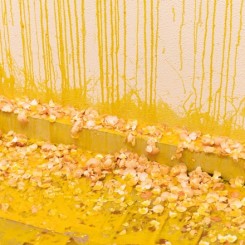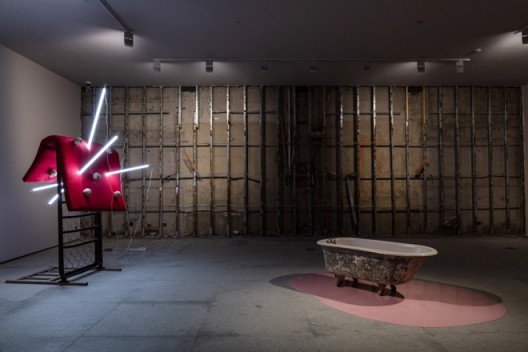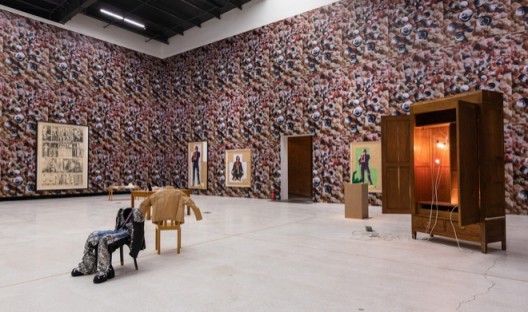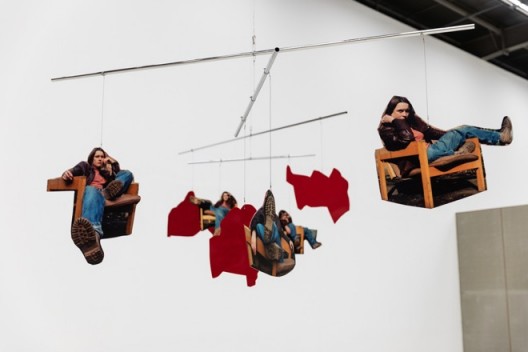Author: Gao Yuan (Ph.D., Critic, Curator)
Translator: Lisa
Sarah Lucas Solo Exhibition
Curator: Yu Shijie
Red Brick Art Museum (Hezhuang Village, Cuizhuang Township, Chaoyang District, Beijing) November 2, 2019 – February 16, 2020
Legendary British artist Sara Lucas has come to China. A part of the Young British Artists generation, Lucas still maintains the spontaneous drive of that era in her work today. It is said that she has never established a permanent studio, preferring instead to borrow a friend’s studio or temporarily use space in her home to work. This nomadic state underlies the improvisational mode that has kept her work both timely and avant-garde. At first glance the exhibition appears to present a set of improvisations, but it is soon evident that there is a logical thread to their combination. Although seemingly “willful” and unrelated, works on show featuring thousands of eggs or smashed cars actually present avenues for the artist to transcend determined gender or identity. Like a non-female, one can actively launch, destroy, and change things instead of passively accepting them.
At the artist’s performance for the exhibition opening, women or men in women’s clothing hurled eggs at a wall. Through this on-site performance work, with its shocking ritualistic aesthetic, the audience was also able to notice the perplexed confusion on the face of the female cleaning staff after the performance. The incomprehension in the women’s eyes is precisely the reason why we need to spread increased awareness and understanding of power. Behind these rough and even caustic works by Lucas is actually a disregard for gender identity—especially a disregard of women’s power as defined by male power. Feminism is the mother of all equal rights movements, or put another way, one could ask: Without feminism, what are human rights? Feminism’s ability to awaken the power consciousness among different levels of society is what makes this exhibition an event of special significance in contemporary China.
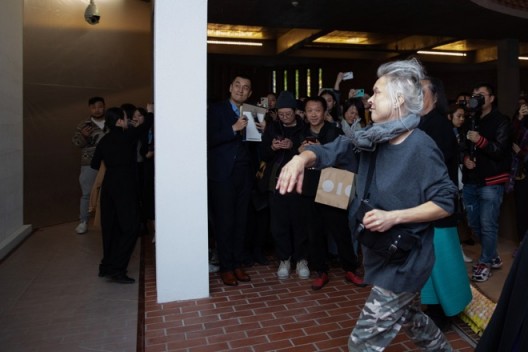
《致女人的一千个鸡蛋》
One Thousand Eggs: For Women
© 莎拉·卢卡斯
© Sarah Lucas
红砖美术馆“莎拉·卢卡斯”开幕现场
Opening of “Sarah Lucas” at Red Brick Art Museum
图片由红砖美术馆提供
Image Courtesy of Red Brick Art Museum
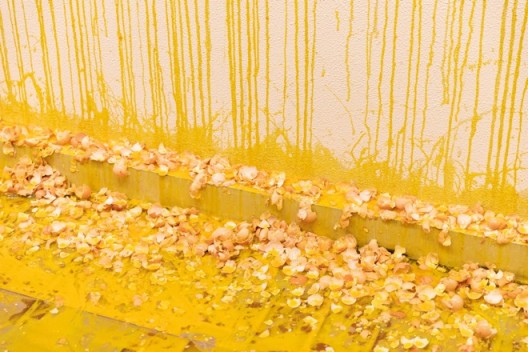
《致女人的一千个鸡蛋》
One Thousand Eggs: For Women
© 莎拉·卢卡斯
© Sarah Lucas
红砖美术馆“莎拉·卢卡斯”开幕现场
Opening of “Sarah Lucas” at Red Brick Art Museum
图片由红砖美术馆提供
Image Courtesy of Red Brick Art Museum
Great contemporary art is able to break through the existence of political and cultural symbols and boundaries, and great “feminist art” should also strive to break through the limitations of gender and identity, while remaining grounded in individual life experience. Only in this way can art truly become a medium and cultural symbol for universal human exchange. Lucas’ ready-made/impromptu installations are directly related to sexual and gender issues, inevitably bringing “feminist” discourses to mind when viewing her works. Here, what should grab our attention are not the causes of the so-called “feminism,” but rather the other avenues of thought that it leads us down. In a certain sense, feminism is the foundation and premise of egalitarianism and postmodern thought; or put another way, it is precisely because of the guiding and demonstrative role of feminist thought that many postmodernist trends of thought have emerged to constitute a re-evaluation and critique of prevalent identity politics and cultural discourses. ”Feminism is not the study of women and gender, but the politicization of gender differences.” (Griselda Pollock, Differencing the Canon) It is through the politicized expression of art, or thinking about various social power relations, that the category of “contemporary art” can be constructed. And the strategies and concerns of contemporary art should also be egalitarian, shared by different classes and races, with artistic forms that are cross-cultural. The aim of feminism is not to erase gender, but to reflect on female identity as defined by (male) power. The improvisational and insolent attitude of Lucas’ work is not a blasphemy against art, but a resistance to an exquisite and elegant feminine art as defined by men. For example, in Lucas’ well-known work “Au Naturel” from 1994, an “improvised” arrangement of fruit and vegetables on a dilapidated mattress serves to symbolize male and female sexual reproductive organs.
Today, when the feminist strains hidden in contemporary art are gradually being uncovered, we should think more about the position of women’s consciousness in the social power system. In the European context, the rise of women’s consciousness began with the French Enlightenment and the French Revolution; throughout the 19th century, a small number of social elites began to pay attention to issues of women’s rights and interests; but it was only in the 20th century that women achieved the most rights in social life, first being realized in written law and then gradually in daily life. It was in the second half of the 20th century when feminist voices and discourses were realized to a significant extent. In step with the large-scale equal rights movements of European and American societies, as an initial discourse of “political correctness,” feminist practice turned from an antagonistic stance of resistance into a habitual mode of thinking—feminists became more introspective and thoughtful, examining myriad aspects of social life in detail to rethink the “female” condition from multiple perspectives. In writings on art, this was reflected in a change from questioning the “canon” in traditional art historical writing to instead focus on examining the modes and positions of viewing and their public effects. Through overstepping and ridiculing women’s “taboos” that originate from the male-dominated order, Sara Lucas highlights a new relationship between art and the public, a type of “post-feminist” perspective that is gradually emerging.

《纯赤》
Au Naturel
莎拉·卢卡斯
Sarah Lucas
1994
床垫,甜瓜,橘子,黄瓜,水桶
Mattress, melons, oranges, cucumber, water bucket
84 x 167.8 x 144.8 cm
© 莎拉·卢卡斯
© Sarah Lucas
由伦敦谋杀我收藏提供
Courtesy Murderme Collection, London
图片由红砖美术馆提供
Image Courtesy of Red Brick Art Museum
When it comes to artistic production, artists must show their perspective based on the premise of “universal female art.” Sara Lucas’ “improvisational” creative approach does just this, avoiding a state of “self-othering.” It is not just female artists for whom this applies; any cultural and political power that is not in conformity with so-called mainstream discourse can easily come to be regarded as an “othering” existence. The power of the “other” is actually a kind of reconstruction of self-awareness in a postcolonial context, and the concept of the “female” is closely related to this existence. Unlike other feminist theorists, Kristeva believes that the “female” cannot be defined. According to her, “female” is outside of naming and ideology: it can only be negative and does not compromise with the state of things as they are. This is in essence a view for women’s complete difference and the position of the other. (Li Jun, The Fable of the Home, 1996) Sarah Lucas effectively uses an “improvisational” method in her work, unleashing it to reject male definitions and differentiated identity, and even to reject the power-driven mechanisms of art collecting. However, under the premise of “universal female art” it is difficult for the “other” in any sense to escape the conventions and ideology of globalized contemporary art.
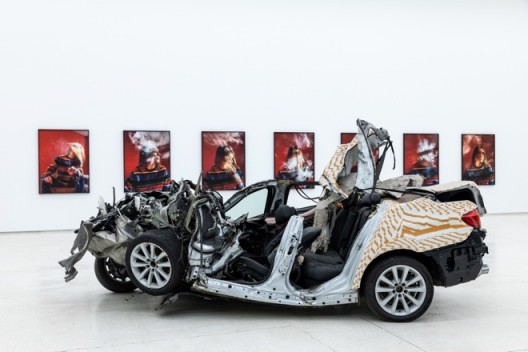
《废话墓志铭》
Epitaph BLAH BLAH
莎拉·卢卡斯
Sarah Lucas
2018
汽车,香烟
Car, cigarettes
210 x 450 x 245 cm
© 莎拉·卢卡斯
© Sarah Lucas
由纽约、墨西哥库里曼兹托画廊及伦敦赛迪 HQ 画廊提供 Courtesy Sadie Coles HQ, London and Kurimanzutto, Mexico City/New York
图片由红砖美术馆提供
Image Courtesy of Red Brick Art Museum

